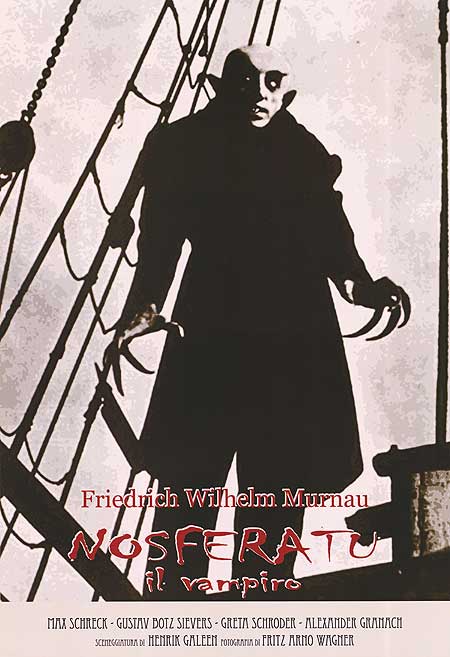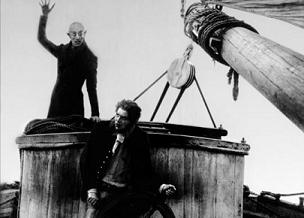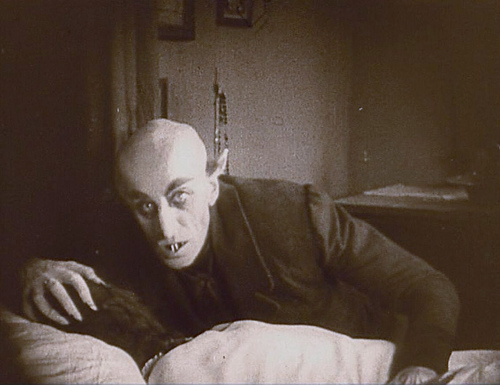
NOSFERATU is a loose adaptation of Bram Stoker’s novel DRACULA. It’s not technically the first vampire film ever made, but in terms of influence and impact, it might as well be. And after over ninety years (!), it’s still scary. I’m not kidding. Imagine for a moment you’re travelling through Romania’s Carpathian mountains. There’s no Holiday Inn around so you have to crash for the night in a dusty old castle. No concierge, no nobody. Not even a mint on your dusty pillow. It’s cold. It’s windy. It’s dark. No hall lights. Not a sound. And all of a sudden this fella is standing at your door.

Hello!
Director F.W. Murnau was one of the most prominent of the German expressionist directors, expressionism being an essential movement in early film that used stark shadows, aggressively creative camera techniques, and almost surreal set designs to enhance mood and atmosphere. German expressionism immediately influenced the unforgettable look of both film noir and the Universal monster movies, to name two major examples of genres that would not otherwise exist. The German expressionists pushed the boundaries of a young medium in ways that continue to inspire and influence filmmakers, whether they’re even aware of the innovations they’re enlisting or not.
Many German expressionist films were horror movies (THE CABINET OF DR. CALIGARI, famously) or felt like them (THE BLUE ANGEL, Germany’s first sound film). Murnau, 6’11 and openly gay, served in World War I. He probably knew something about intensity. This is borne out by his films, or at least the ones I’ve seen, that having most often been NOSFERATU.

The word “nosferatu” is possibly invented, almost certainly meant to appear to be Romanian. Bram Stoker didn’t invent the word but he sure popularized it. Stoker’s 1897 epistolary novel collected aspects of the Romanian historical figure Vlad The Impaler and mixed in a hodgepodge of supernatural elements (the bloodsucking, the hypnosis, the ability to transform into animals) in order to create the character of Count Dracula. Murnau’s film was not allowed to use that name in their adaptation, although some versions of NOSFERATU do insert that name into the credit title cards. In NOSFERATU we know him as Count Orlok, which is fine, because NOSFERATU simultaneously exists alongside the Dracula legend and apart from it. It’s an essential piece of the foundation of Dracula’s place in popular culture, while somehow feeling separate and unique.

It’s fascinating to consider the many countenances of Dracula over the years. The single most famous — and to many people the definitive — image of Dracula is that of Bela Lugosi: handsome, debonair, very European in a cosmopolitan way (in Tod Browning’s DRACULA the Count is shown attending the opera!) If you went by Stoker’s descriptions in the original novel, Count Dracula would look a lot like James Coburn, with the wardrobe of Johnny Cash. Vlad The Impaler, of course, looked a whole lot like Spinal Tap’s Derek Smalls. The Christopher Lee Dracula is iconic, but the image is probably more associated with the wonder that is Christopher Lee than with Dracula himself, at least in American minds. Gary Oldman’s “Aunt May” rendition of Dracula never seemed to take hold in the popular imagination. But Max Shreck’s Count Orlok in NOSFERATU is wholly original. Bald, pointy-eared, beady-eyed, with long talons for fingers, he cuts a striking, disturbing figure. Count Orlok has a mouthful of sharp teeth meant to emphasize his resemblance to a plague-carrying rat. Again — historical significance comes packaged within horror movies, always has. Personally I see a lot of Count Orlok in former New York mayor Rudy Giuliani, but that’s a compliment to neither.

Max Shreck’s performance as the cadaverous Count Orlok is so bizarre and creepy that an entire movie was made with the premise that he wasn’t entirely acting (SHADOW OF THE VAMPIRE), and it’s hard to not consider the eerie believability of that premise while re-watching NOSFERATU. I mean, it’s not like make-up effects were generally that advanced back then. Rick Baker hadn’t even been born yet! Shreck really makes the most of a shocking visage, a hunched posture and angular motions — it’s a tremendous feat of silent acting. Once you’ve seen this film and this performance, you won’t forget it. The proof is in the pudding.

The influence of NOSFERATU carries through decades. The great German director Werner Herzog and his most German of muses, Klaus Kinski, made NOSFERATU THE VAMPYRE in 1979. Also in 1979 came an adaptation of Stephen King’s SALEM’S LOT, wherein the vampire Kurt Barlow looks pretty familiar if you’ve seen any of the pictures of Count Orlok included here. Christopher Walken in 1992’s BATMAN RETURNS plays a gaunt Walken-y character named Max Schreck. For the record, it’s Wes Craven’s choice for the best horror movie ever.
NOSFERATU is as effective and as essential a horror film as it ever was. If you’re the type who’s harboring some reticence over jumping into silent films — hey, I was once too — there’s no better place to start than here.
NOSFERATU is playing at the Landmark Loew’s Jersey tonight, as they say “with Live Organ Accompaniment on the Loew’s Wonder Morton Organ by Ben Model.” Sounds great!
— JON ABRAMS (@jonnyabomb)
- [THE BIG QUESTION] WHAT’S YOUR FAVORITE FEMALE ENSEMBLE IN MOVIES? - July 22, 2016
- [IN THEATERS NOW] THE BOY (2016) - January 24, 2016
- Cult Movie Mania Releases Lucio Fulci Limited Edition VHS Sets - January 5, 2016
Tags: 31 flavors of horror, F.W. Murnau, Horror, Max Schreck, Screenings, vampires





No Comments